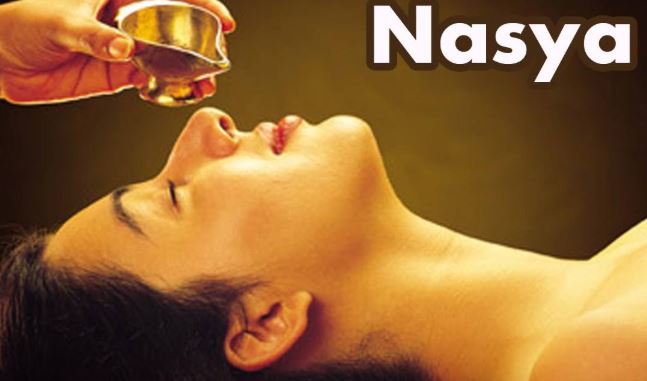Nasya Karma in Cosmetology: An Anatomical Approach - A Natural Solution for Skin and Hair Wellness
DOI:
https://doi.org/10.21760/jaims.10.6.27Keywords:
Nasya Karma, Cosmetology, Ayurveda, Anatomical Approach, Skin Wellness, Hair HealthAbstract
In Ayurveda, Nasya Karma is a specialist therapeutic treatment that involves administering medication via the nose. Traditionally used to treat problems of Urdhvajatrugata (above the collarbone), its use in cosmetology is becoming more well-known because of its effects on the head and face. The anatomical foundation, conventional wisdom, and current applicability of Nasya Karma in skin and hair health are examined in this paper. The relationship between neurovascular networks and nasal administration pathways that impact skin texture, hair development, and rejuvenation is highlighted. This article examines the fundamentals of Nasya Karma, its workings, and its uses in enhancing facial characteristics, halting hair loss, and improving skin texture.
Downloads
References
Thorne RG, Pronk GJ, Padmanabhan V, Frey WH. Delivery of insulin-like growth factor-I to the rat brain and spinal cord along olfactory and trigeminal pathways following intranasal administration. Neuroscience. 2004;127(2):481–96.
Costa C, Lazzarini R, Silva C. Cutaneous neurogenic inflammation and skin disorders: an integrative view. Clin Dermatol. 2019;37(5):452–61.
Doty RL. The olfactory system and its disorders. Semin Neurol. 2009;29(1):74–81. doi:10.1055/s-0028-1124025.
Baumeister RF, Vohs KD. Hormonal influences on human function: The case of cortisol and DHEA. Horm Behav. 2014;66(3):416–24. doi:10.1016/j.yhbeh.2014.06.018.
Illum L. Nasal drug delivery—possibilities, problems and solutions. J Control Release. 2003;87(1-3):187–98. doi:10.1016/S0168-3659(02)00363-2.
Vaidya AD. Marma science and its importance in Ayurveda. J Res Ayurveda Siddha. 2003;24(1):15–22.
Kohli K, Meher BR, Prajapati VK. Nasal lymphatic drainage and its relevance in drug delivery and detoxification. Int J Pharm Investig. 2020;10(3):138–42. doi:10.5530/ijpi.2020.3.29.
Charaka. Charaka Samhita. Sutra Sthana. Ch. 5. Varanasi: Chaukhambha Sanskrit Series.
Sushruta. Sushruta Samhita. Uttara Tantra. Ch. 25. Varanasi: Chaukhambha Orientalia.
Lundy L, et al. Anatomy and function of the nasal cavity and sinuses. Otolaryngol Clin North Am. 2010;43(3):485–95.
Rodrigues F, et al. The trigeminal system in skin aging and repair: novel targets for rejuvenation therapies. Dermatol Ther. 2021;34(1):e14747.
Born J, et al. Sniffing neuropeptides: nasal delivery bypasses the blood–brain barrier. Science. 2002;296(5577):1409–10.
Maigler B, et al. Intranasal drug delivery: physiological basis and current status. Int J Res Appl Sci Eng Technol. 2024;12(6):645–53.
Singh R, et al. Role of olfactory nerve in direct brain drug delivery via nasal route. Int J Res Appl Sci Eng Technol. 2020;8(9):1200–7.
Lee D, Minko T. Mechanisms and barriers of nasal drug delivery. Pharmaceutics. 2021;13(3):412.
Terrier P, et al. Trigeminal nerve structure and function in intranasal transport. Neurosci Lett. 2022;768:136370.
Bourganis V, et al. Role of blood circulation in nasal drug absorption. Eur J Pharm Sci. 2018;113:26–38.
Zhang Q, et al. Advances in nanoparticle-based nose-to-brain delivery systems. Int J Nanomedicine. 2023;18:2125–38.
Pundir A, Jain P, Singh A. Nasya: a drug delivery route in Ayurveda. AYU. 2010;31(3):354–60.
Reddy PG. Clinical efficacy of Anu Taila Nasya in sinusitis. AYUSH Res Bull. 2014;5(2):20–4.
Varier PS. Indian Medicinal Plants. Vol. 2. Chennai: Orient Longman; 2003.
Nadkarni KM. Indian Materia Medica. Vol. 1. Mumbai: Popular Prakashan; 2000.
Singh RH. Exploring the scientific basis of Nasya therapy in Ayurvedic pharmacology. J Res Ayurveda Siddha. 1994;15(1):30–5.
Kumar A, Gupta R, Patel M. Nasya therapy and autonomic modulation: a pilot study. J Ayurveda Integr Med. 2022;13(1):67–72.
Sharma PV. Chikitsa Sthana of Charaka Samhita. Varanasi: Chaukhambha Orientalia; 2014.
Dwivedi A, Tiwari S. Role of Nasya in hair fall: a clinical study. AYU. 2016;37(1):64–70.
Kiran R, Mishra A. Ayurvedic facial rejuvenation: detox pathways. Int J Ayurvedic Med. 2018;9(4):301–5.
Sharma S. Lymphatic drainage and facial beauty in Ayurveda. J Ayurveda Case Rep. 2021;5(2):89–91.
Singh A, Mishra N. Detoxification pathways via Nasya. J Drug Deliv Ther. 2019;9(5):120–4.
Vohora SB. Medicinal plants for immunity: Neem and Guduchi. Indian J Pharm Sci. 2002;64(1):13–7.
Bhat S, Narayana A. Nasya Karma and neuroendocrine regulation. Anc Sci Life. 2011;30(4):60–5.
Rathi B, Tiwari V. Hormonal balance and Nasya therapy. J Ayurveda Integr Med. 2015;6(2):123–8.
Joshi H, Parle M. Bhringraj as a hair revitalizer. Int J Green Pharm. 2011;5(1):27–30.
Patgiri BJ, Prajapati PK. Standardization and efficacy of Brahmi Taila. AYU. 2010;31(3):386–90.
Dey S, Sahu S. Scalp conditions and Nasya intervention. J Res Indian Med. 2018;6(1):45–9.















